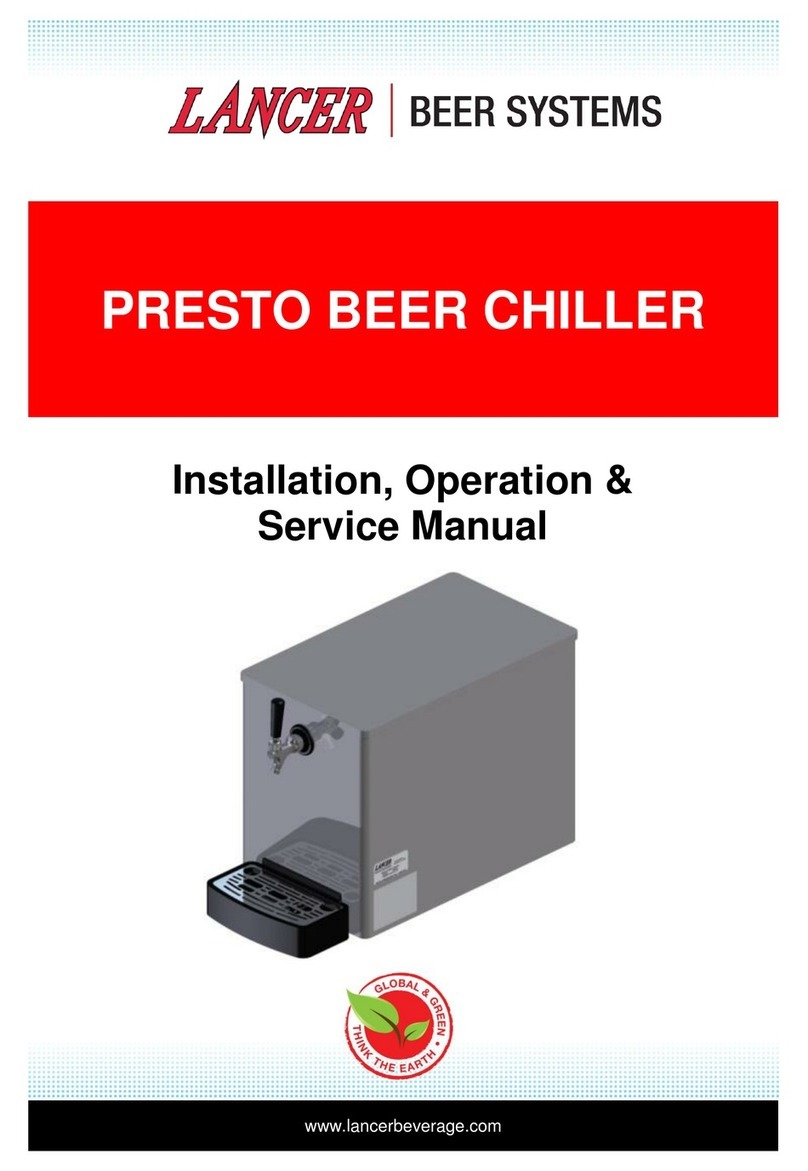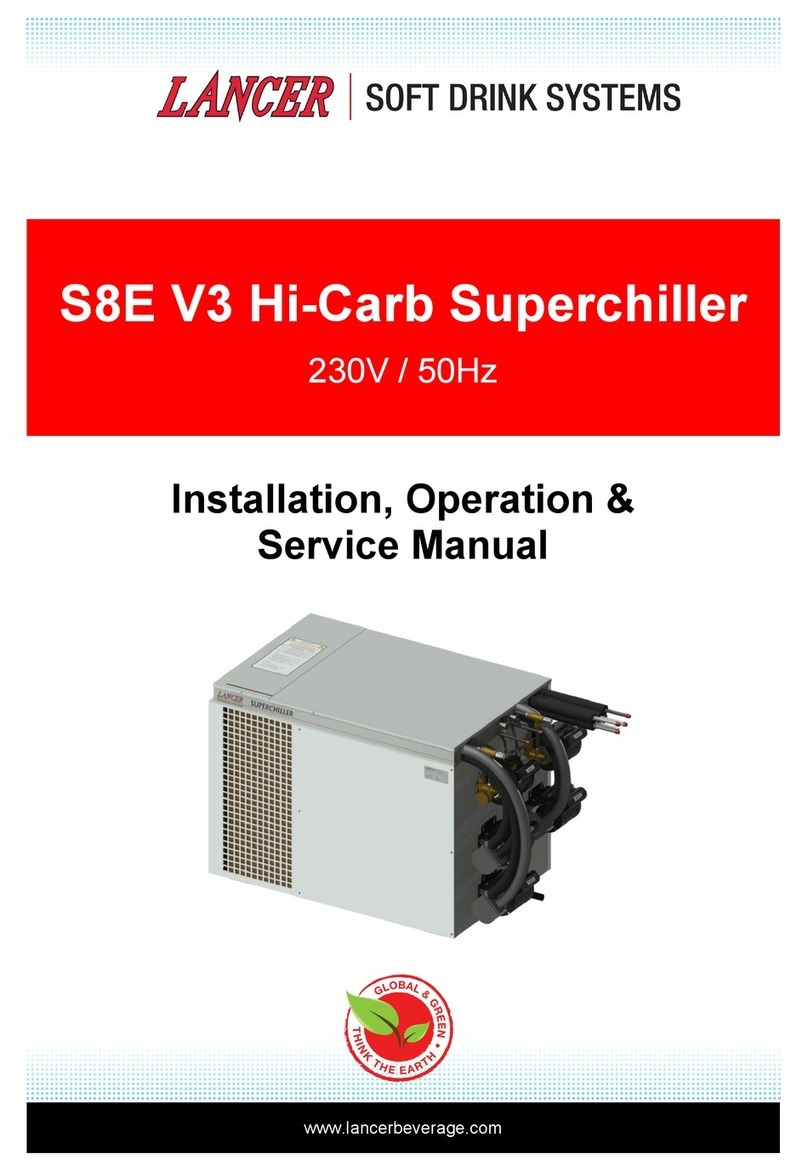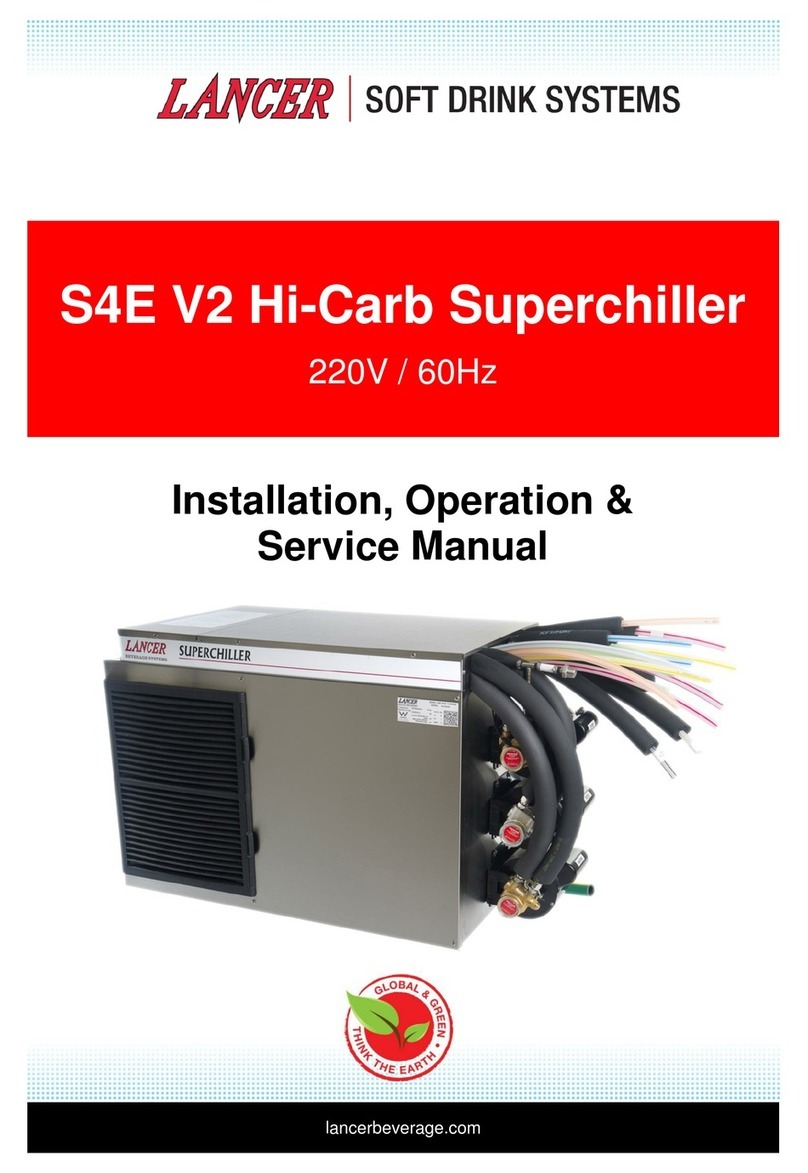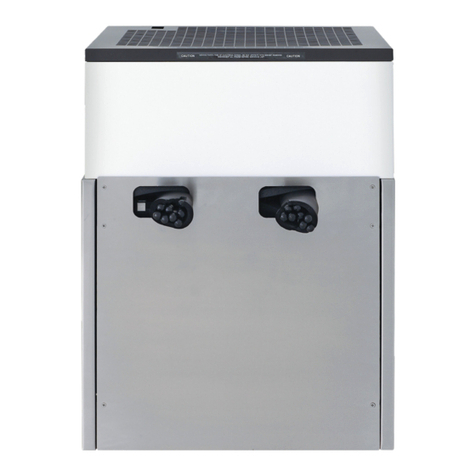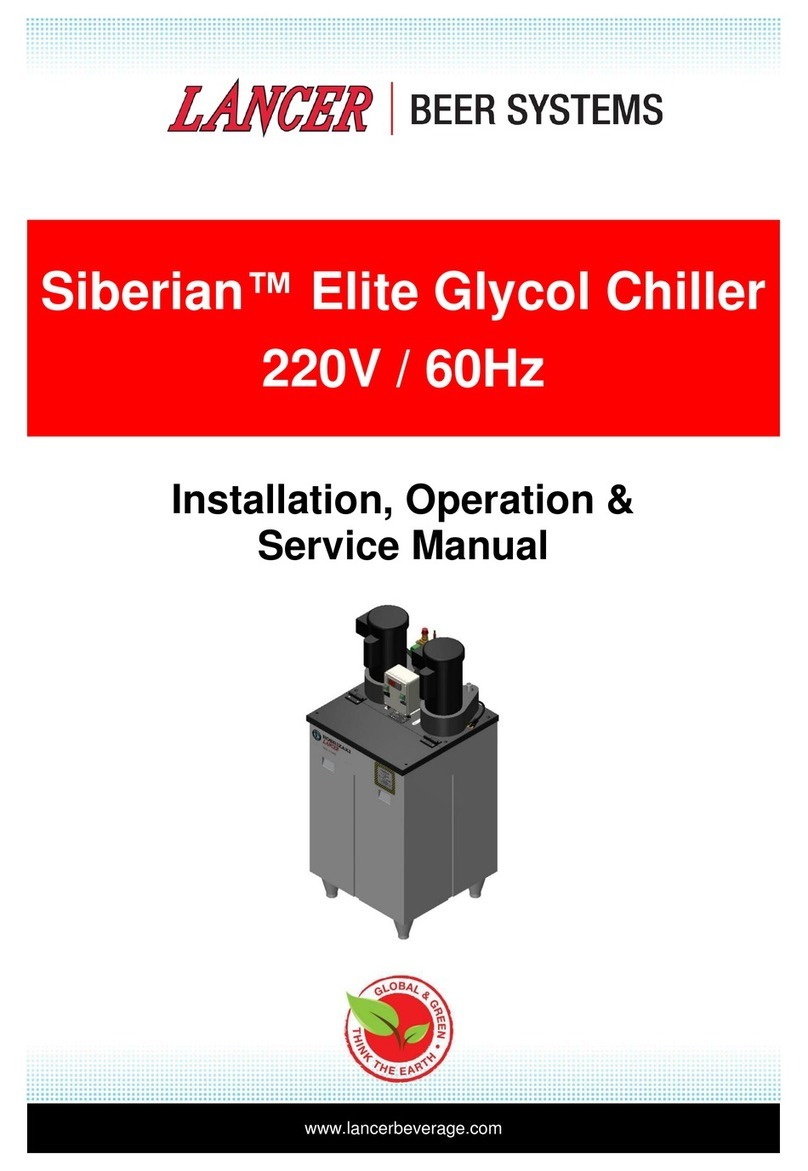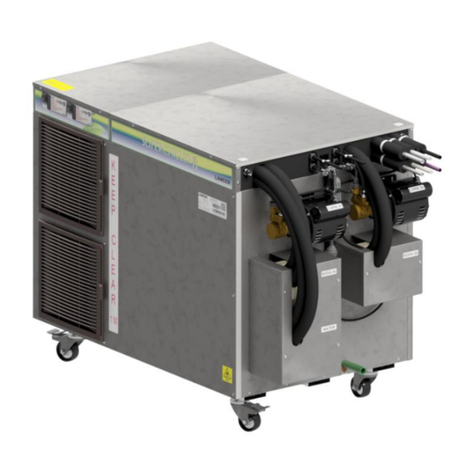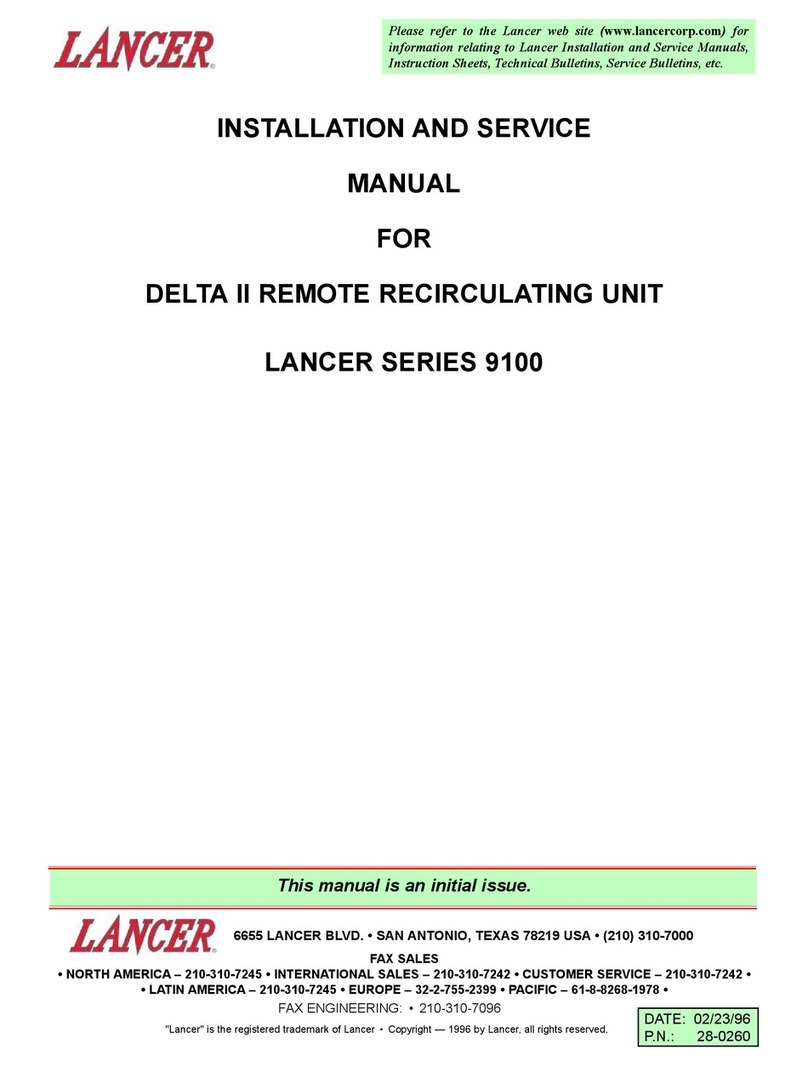
7
• Usesanitarygloveswhencleaningtheunitand
observe all applicable safety precautions.
• DO NOTuseawaterjettocleanorsanitizethe
unit.
• DO NOTdisconnectwaterlineswhencleaning
and sanitizing syrup lines, to avoid contamination.
• DO NOTusestrongbleachesordetergents;These
can discolor and corrode various materials.
• DO NOTusemetalscrapers,sharpobjects,steel
wool,scouringpads,abrasives,orsolventsonthe
dispenser.
• DO NOTusehotwaterabove140°F(60°C).This
candamagethedispenser.
• DO NOT spill sanitizing solution on any circuit
boards. Insure all sanitizing solution is removed
fromthesystem.
! ATTENTION
Thecleaningproceduresprovidedhereinpertaintothe
Lancerequipmentidentiedbythismanual.Ifother
equipmentisbeingcleaned,followtheguidelines
establishedbythemanufacturerforthatequipment.
NOTE
CLEANING AND SANITIZING
General Information
• Lancer equipment (new or reconditioned) is shipped from
the factory cleaned and sanitized in accordance with NSF
guidelines. The operator of the equipment must provide
continuous maintenance as required by this manual and/or
state and local health department guidelines to ensure prop-
er operation and sanitation requirements are maintained.
• Cleaning should be accomplished only by trained personnel.
Sanitary gloves are to be used during cleaning operations.
Applicable safety precautions must be observed. Instruction
warnings on the product being used must be followed.
Cleaning Solution
Mix a mild, non-abrasive detergent (e.g. Sodium Laureth
Sulfate, dish soap) with clean, potable water at a temperature
of 90°F to 110°F (32°C to 43°C). The mixture ratio is one
ounce of cleaner to two gallons of water. Prepare a minimum of
ve gallons of cleaning solution. Do not use abrasive
cleaners or solvents because they can cause permanent
damage to the unit. Ensure rinsing is thorough, using clean,
potable water at a temperature of 90°F to 110°F. Extended
lengths of product lines may require additional cleaning solution.
Sanitizing Solution
Prepare the sanitizing solution in accordance with the manu-
facturer’s written recommendations and safety guidelines. The
type and concentration of sanitizing agent recommended in
the instructions by the manufacturer shall comply with 40 CFR
§180.940. The solution must provide 100 parts per million (PPM)
chlorine (e.g. Sodium Hypochlorite or bleach) and a minimum of
ve gallons of sanitizing solution should be prepared.
Cleaning and Sanitizing Syrup Lines - Bag in Box
1. Disconnect syrup lines from BIB’s
2. Place syrup lines, with BIB connectors, in a bucket of warm
water.
3. Activate each valve to ll the lines with warm water and ush
out syrup remaining in the lines.
4. Prepare Cleaning Solution described above.
5. Place syrup lines, with BIB connectors, into cleaning
solution.
6. Activate each valve until lines are lled with cleaning
solution then let stand for ten (10) minutes.
7. Flush out cleaning solution from the syrup lines using clean,
warm water.
8. Prepare Sanitizing Solution described above.
9. Place syrup lines into sanitizing solution and activate each
valve to ll lines with sanitizer. Let sit for ten (10) minutes.
10. Reconnect syrup lines to BIB’s and draw drinks to ush solu-
tion from the dispenser.
11. Taste the drink to verify that there is no o-taste. If o-taste
is found, ush syrup system again.
Followingsanitization,rinsewithend-useproduct
untilthereisnoaftertaste.Donotuseafreshwater
rinse.Thisisansfrequirement.Residualsanitizing
solutionleftinthesystemcreatesahealthhazard.
! CAUTION
Cleaning and Sanitizing Syrup Lines - Figal Tank
1. Disconnect syrup inlet from the gal syrup tank.
2. Prepare cleaning solution and using a plastic bristle brush,
scrub both disconnect valves on gal tank with cleaning
solution and rinse with clean, potable water.
3. Prepare sanitizing solution and using a spray bottle or clean
cloth, sanitize both disconnect valves on gal tank and allow
to air dry.
4. Turn o CO2supply.
5. Connect syrup line to syrup tank lled with clean, potable
water.
6. Connect CO2 line to tank lled with water and pressurize.
7. Activate appropriate valve to ll the line with water and ush
out syrup remaining in the line.
8. Disconnect CO2 line and syrup line from tank lled with
water.
9. Fill a seperate tank with cleaning solution and connect syrup
line and CO2line to tank and pressurize.
10. Activate appropriate valve to ll the line with cleaning
solution then let stand for ten (10) minutes.
